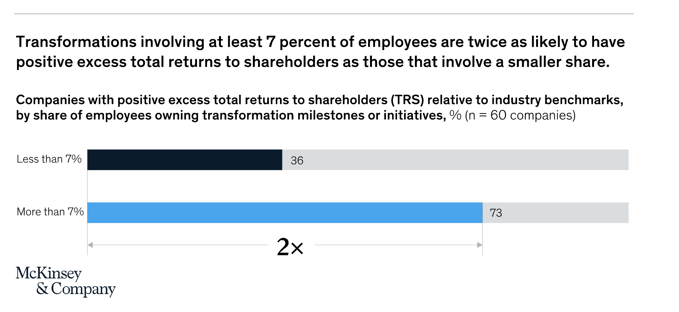+
Get in touch 👋🏽
We would love to hear from you.
Contact us to see how we can help.
We would love to hear from you.
Contact us to see how we can help.

Change is the lifeblood of business; it is core to any company’s ability to innovate, thrive, and remain competitive. As Jack Welch famously said:
"If the rate of change on the outside exceeds the rate of change on the inside, the end is near"
----- Jack Welch, Former CEO of General Electrics -----
He argues that the only way for businesses to thrive is to create a culture of innovation and always seek new opportunities to adapt to the market. Yet, the road to successful transformation is fraught with complexity. Businesses must adapt to not just survive, but to seize opportunities to lead and innovate.
And according to Deloitte, this is becoming increasingly urgent:
"21st century enterprises will rise and fall depending on their ability and willingness to transform continuously and advantageously in the face of change and disruption"
----- The Exponential Enterprise Report, Monitor Deloitte, 2021 -----
Typically, change management or 'transformation' projects are concerned with large-scale shifts in a business such as new corporate strategies, new leadership, digital transformation, structural and operational changes, relocation, and mergers to name a few.
While these projects are pivotal for growth, their high failure rate calls for deeper understanding to help build nuanced strategy.
A staggering 70% of all change programs fail, and the costs go far beyond simple monetary losses. Opportunity cost, employee dissatisfaction, and reputational damage are among the risks businesses face if they fail to keep things on track. Understanding the complexities of transformation is not just a theoretical exercise—it's a business imperative.
So what makes change management so difficult?
The reasons can broadly be categorised into two main sections:
But engaging employees isn’t an easy ask. According to Gallup, only 23% of the workforce feels engaged at work and disengaged staff cost the economy nearly $9 trillion to the global economy.
People are naturally resistant to change, thanks, in part to an in-built, neurological dislike of uncertainty. In the workplace, this resistance is often exacerbated by the feeling that change is done TO employees rather than WITH them. And this is leaving employees feeling disconnected from the company's future.
Without a shared understanding of the goals and benefits of the change, even the most well-intentioned strategies can struggle or fail.
So what happens if you run a change project without engaging your employees?
The most obvious risk is that your project doesn’t achieve its goal. This might mean expansion into a new market fails, or staff don’t get behind a new CEO, resulting in irreparable damage to the organization’s leadership. But more importantly, your company’s inability to transform puts it at risk of being left behind and as we noted earlier, survive the fast-moving business landscape.
Failing to engage your employees in change can reduce staff morale and exacerbate the disengagement rate impacting productivity, the ability for your team to collaborate, churn rates and eNPS.
It can affect your company culture, and build up resistance to future changes, making it harder for your business to become or remain adaptable. Each failure along the way makes future success that little bit harder and depletes chances to develop the culture of innovation and continuous learning Welch advocates for.

Here's a beacon of hope: research indicates that engaging just 7% of your workforce can double your success rates in change initiatives.
 Rather than passive spectators, your employees become active champions as 'stakeholders' in the transformation.
Rather than passive spectators, your employees become active champions as 'stakeholders' in the transformation.
The result is a shared ownership where people feel like they have a part to play. Engaged employees are more likely to embrace change, contribute innovative ideas, and support the organisation's vision.
Leaders need to ensure they have a robust employee engagement plan in place before kicking off their transformation project. Fostering understanding and conviction in the project is so important that it is considered one of the 4 key building blocks of business transformation by McKinsey.
So let’s look at actionable strategies to engage employees in change.
You need a CEO who is completely committed to the transformation and treats it as a top priority. That person must be willing to devote a high level of engagement, attention, and focus to the project. With the most senior person accountable, not only will the project have the best chance to succeed, be followed up and be resourced properly, but it will also demonstrate the importance of the change to all employees who will then be more likely to follow suit.
Collaboration is another ingredient in successful change management. Promoting teamwork and the sharing of ideas helps break down silos. Working with their colleagues also builds accountability in your employees. Turning a high-level company mandate into a team effort makes people feel heard and will increase motivation and commitment to the project.
Whatever your change mechanism is, appointing a change agent or change champions as part of a network through your organization can go a long way. They can act as spokesperson for the project, show shared accountability and ownership with trusted functions outside of their designated job titles, can be points of contact for colleagues, identify issues and help spread the word.

Your employees will appreciate being updated on the projects and being listened to. Doing so shows that this isn’t simply a change that’s being forced on them; it’s one that you are all working towards together. A key part of this is showing that the leadership is listening and continuing to share the rationale behind changes and decisions.
Break your action plan into smaller achievable steps and celebrate them. That way, you will create momentum, keep employees engaged and informed, showcase their value along the way and keep motivation levels high.
Most employees have heard too many broken promises or grand claims that are never backed up. When you say you’re going to do something, follow through with it! It isn’t just about taking action itself, but about involving your employees in the activities you’re undertaking, so that they understand and are involved in the process of change.
Employee ideas programs are highly effective in driving transformation projects by creating high levels of engagement, shared ownership and a culture of innovation. They typically include all the elements outlined in the previous chapter and can therefore act as a tool to drive the change you want to see whilst engaging employees.
CEO-led employee ideas programs focused on ideas related to the transformation demonstrate just how committed a company is to both the change itself and the valuable opinions of its employees. It helps build a two-way communications channel, making people feel heard, and increasing loyalty whilst also finding potentially valuable ideas.
I am delighted to have had a ‘yes’ from Stuart. I cannot wait to see my idea in action and make a difference to the company I am so proud to be working for.
----- Lesley, Front line worker @ Marks & Spencer -----
Employee ideas programs that encourage collaboration also support transformation projects increasing employees’ buy-in to each other’s ideas and creating a culture where innovation is rewarded and valued.
These programs are the perfect vehicle to engage employees to take on advocate roles and act as actors of change within their organizations. Balfour Beatty has a team of 50+ volunteers from across the business who are tasked to help answer questions and promote their ‘My Contribution’ scheme – a role they take on with pride and help support them to build their profile within the organization.
Employee ideas initiatives inherently rely on keeping the workforce engaged and in the loop. Committing to an employee idea program forces companies to communicate with employees on the progress of ideas, the ones that are brought to life, celebrating wins and showcasing action. Luckily, integrated employee idea management platform help large companies to automate those processes and work alongside program owners to ensure a constant stream of strategic communications.
In 2022, Stuart Machin took over as Marks & Spencer CEO from Steve Rowe. With a very loyal workforce of over 65,000 colleagues across 450 sites and a strong embedded culture, the leadership team needed a mechanism to support Stuart’s new tenure. The team used an employee ideas program to create a catalyst for change and showcase Stuart as the listening leader he is whilst giving colleagues a direct line to the leadership, developing a strong shared ownership.
Alongside the value these ideas have brought, M&S truly positioned Stuart as a listening leader and created buy-in in his leadership by giving everyone a voice.
“Straight to Stuart is about giving every 65,000 of our colleagues a platform to drive positive change and make a difference - that’s what makes the program so powerful.”
----- Stuart Machin, CEO @ M&S -----
M&S’ CEO commitment to this initiative led to ‘Straight to Stuart Live’; open video conferences where employees are encouraged to ask questions, ideas roadshows, Machin actively engaging with every single one of the 11,000 ideas and bringing >700 of those to life. Powered by an integrated platform, this employee ideas program has helped demonstrate that the people in charge are not just listening to, but implementing, ideas from employees and created an organisation-wide buy into the new leadership transition.
Spanish airline Vueling recognized a need to transform its business after the COVID-19 pandemic. In our “Listening with purpose” webinar, Head of Transformation Veronica Hull mentions how Vueling’s leadership had identified that “transformations generally don’t succeed unless they empower and meet the needs of all the people within an organization.”
With a highly disparate workforce, engagement at scale was a challenge. However, the decision to run their employee ideas through the native integration of Sideways 6’s Ideas App for Microsoft Teams meant that all employees could be involved in the initiative. Their employee ideas program - ‘Make it better’ – focuses on linking feedback from frontline staff into their transformation efforts driving engagement in change, and helping the company make progress towards important strategic goals.
"We want people to fall in love with Vueling and the best way to engage people is to let them know that they are part of the future. If they know they are a part of the future, they will want to make it brilliant."
----- Heather Figallo, Chief Transformation Officer @ Vueling -----
The first challenge immediately engaged 30% of the workforce and the ideas implemented saved them 1/4 of their four-year cost saving target in just 12 weeks. Not only did the program help develop engagement in transformation by creating shared ownership, but Vueling made significant cost savings in the process.
Recent years have highlighted the importance of adaptability for survival in the business world, as well as the opportunities to thrive for the most flexible companies. This makes successful transformation critical to business success.
But change management can be difficult without employee’s engagement in the change.
An employee ideas program can be a secret weapon for businesses, helping them achieve their strategic outcomes while also driving engagement in the change you want to make happen, creating shared ownership, fostering innovation, and enhancing collaboration and communication across an organization.
If you want to discover how our idea management software can help you build an employee ideas program that will boost your change management journey, get in touch today.
Ideas from Anywhere™
Sideways 6 exists to help bring good ideas to life every day, everywhere from everyone.
»